Last updated on April 26, 2024
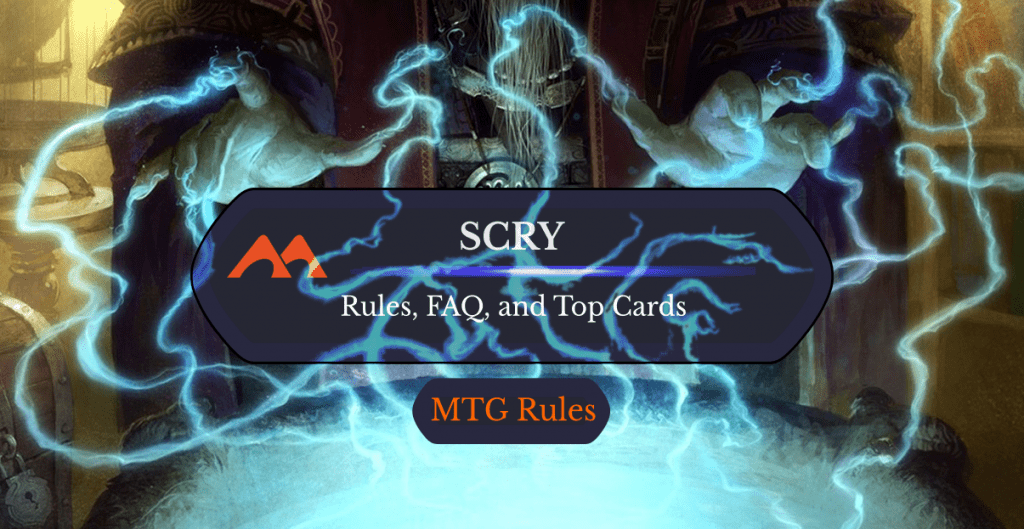
Preordain | Illustration by Svetlin Velinov
Come, let me peer into your mind and read your future. Ahh, yes, I see it all so clearly. You’re about to learn about scrying in Magic: The Gathering. A great teacher and L1 judge will walk you through how it works, the history of the mechanic, and some interesting tips and tricks for scrying. That, dear reader, is your destiny.
But wait! I see another vision! Something about… squirrels and cheese? Hmm… maybe we should just focus on that scry thing, eh?
How Does Scry Work?

Temple of Enlightenment | Illustration by Piotr Dura
Whenever you scry X, you look at the top X cards of your library and put any number of them on the top and/or bottom of your library in any order. Scry 1 is a simple decision of putting a card on top vs bottom, but larger scry numbers require more decision-making since the cards can be split up and rearranged however you choose.
History of Scry
Looking into the past for the history of scry… ironic, ain’t it?
Scry was introduced as a named mechanic on a handful of cards from Fifth Dawn, followed by a second appearance in Future Sight (get it?). It made a much bigger splash when it reappeared in Theros as a headlining returning mechanic. It made sense, given all the omens and oracle fortune-telling going on in Greek mythology. Scry would remain front and center for the rest of that block though Born of the Gods and Journey into Nyx.
It wasn’t until Magic Origins that Wizards loosened the reins and inducted scry into the game as an evergreen mechanic, meaning it could show up in any set as the developers saw fit without the need to fit the flavor or worldbuilding of that set. It’s been used liberally ever since and appears in just about every set, often used as a bonus to a standard card effect.
Scry has evolved to the point where it was incorporated into the mulligan rules for a while (more on that later), and it’s been used as a build-around mechanic for commanders like Elminster and Kenessos, Priest of Thassa, as well as the Limited archetype in Lord of the Rings: Tales of Middle-earth on cards like Lost Isle Calling and Elrond, Master of Healing.
The astute historians among you might’ve noticed via Scryfall searches that there are scry cards that predate its “introduction” in Fifth Dawn. That’s because any card with the scry effect has been errata’d to use scry text, even if the mechanic wasn’t originally written on the card. A quick look at Darksteel Pendant’s oracle text should clear that up. That technically makes Soldevi Excavations the first card with the scry effect, back in 1996!
Can You Rearrange Cards When You Scry?
Yes, you have full control over how the cards are arranged when scrying. This doesn’t matter for scry 1, but if you scry 2, for example, you can put both cards on top in whichever order you choose. Same goes for any cards you put on the bottom instead.
What Does Scry 1, 2, 3, etc. Mean?
The number associated with scry is the number of cards you look at from the top of your library. Scry 1 means you’ll peek at the top card of your library and choose whether to put it on top or bottom, Scry 2 means you’ll look at the top two simultaneously, and so on with scry 3, scry 4, and even scry 100.
Does Scry Stack in MTG?
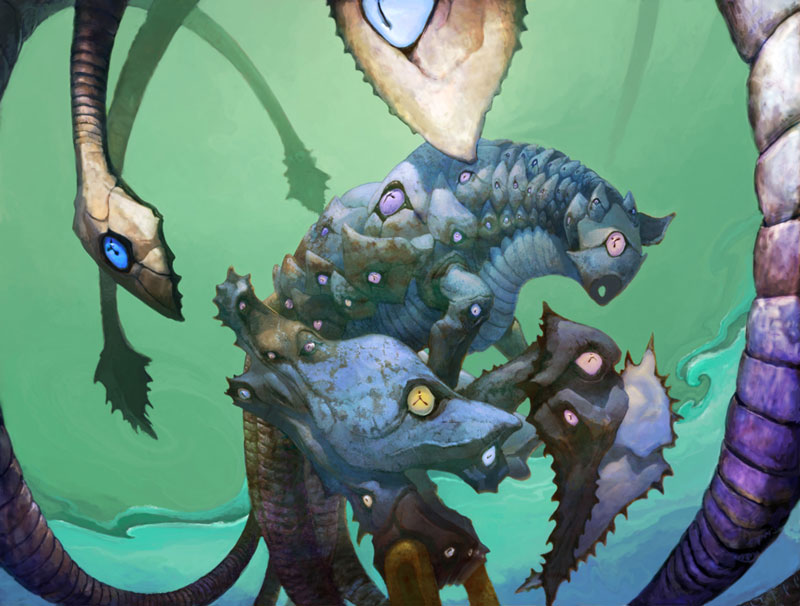
Cryptic Annelid | Illustration by Anthony S. Waters
Individual instances of scry don’t combine into a single number, but they do stack in the sense that scry triggers all resolve separately if a card somehow lets you scry multiple times.
For example, assume you attack with a creature that’s enchanted with Aqueous Form and a Sorcerer role. That’s two instances of the text “when this creature attacks, Scry 1.” However, you won’t scry 2 when that creature attacks; rather, two separate triggers go onto the stack, and you’ll scry 1, followed by another scry 1.
Is It Better to Scry Before or After You Draw?
General consensus is that it’s usually better to scry before drawing. In fact, this is basically a proxy for the question: Which is better, Serum Visions or Preordain.
Assuming you’re looking for something specific, maybe a timely removal spell to stop yourself from dying, you want to give yourself the best chance to find that card. Scrying first digs further for the card you need, while drawing first means you’re relying on the exact top card of your library to be what you’re looking for.
Of course, if you’re not in a do-or-die situation and you don’t care what you draw, the decision doesn’t matter much. If you’re trying to set up the top of your library for a later turn, you might want to draw first then scry towards cards you want to draw later on.
Does Scry Count as Searching Your Library?
Nope, scrying isn’t searching a library. Calm down Opposition Agent. In fact, scrying maintains the order of your library up until the point where you rearrange the cards you’re looking at.
Do You Still Scry When You Mulligan?
No, this is no longer an official part of the game. If the question sounds strange to you, there used to be a “scry rule” in effect when mulliganing. The “Vancouver Mulligan”, as it was called, allowed a player to scry 1 after resolving mulligans, but the player would draw one fewer card per mulligan. They wouldn’t redraw up to seven cards as we do with the current “London Mulligan”.
What If My Target for Fading Hope Was Removed, Do I Still Scry?
No. If a targeted spell like Fading Hope has a scry effect tacked on, the spell needs to resolve in order to actually scry. If there’s a single target and the target is removed before resolution, the entire spell fizzles, scry and all. Similarly, if a card like Bolt of Keranos targets you and you give yourself protection from red in response, Bolt of Keranos doesn’t resolve, and the opponent doesn’t scry.
Scry vs. Surveil; What’s the Difference?
Surveil is a separate card selection mechanic that gives you the choice to put cards in your graveyard as an alternative to keeping them on top of your library. The key difference is that you can’t put cards on the bottom of your library while surveilling, only the top or graveyard. Generally speaking, surveil is better than scry, since putting cards in your graveyard is almost always an advantage over tucking them on the bottom of your library.
How Do You Scry in MTG Arena?
I put together this 40-land scry deck and beat up on Sparky for a bit to demonstrate how the mechanic works on Arena, so follow along.
The card we’re working with here is Track Down, which has scry 3 and some extra text.
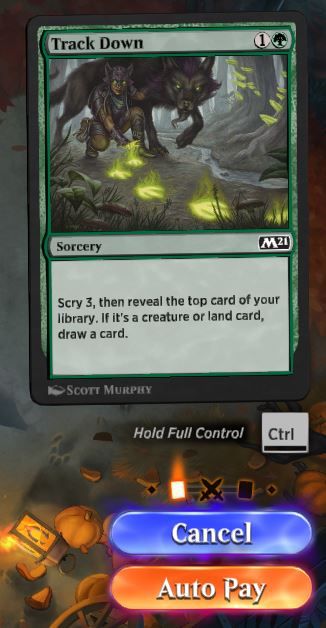
When the spell resolves, the Scry window opens, showing me the top three cards of my library displayed on top of the rest of the deck. Note that while doing this, Sparky said something like “patience is important in this game.” More like Snarky, am I right?

Now you can move the cards you don’t want to the bottom of your deck (left of the card sleeve image), and anything to the right of the card sleeve stays on top. The card furthest to the right will be the top card of your library. In this image, I don’t need more lands, so they go to the bottom, and the battle stays on top.
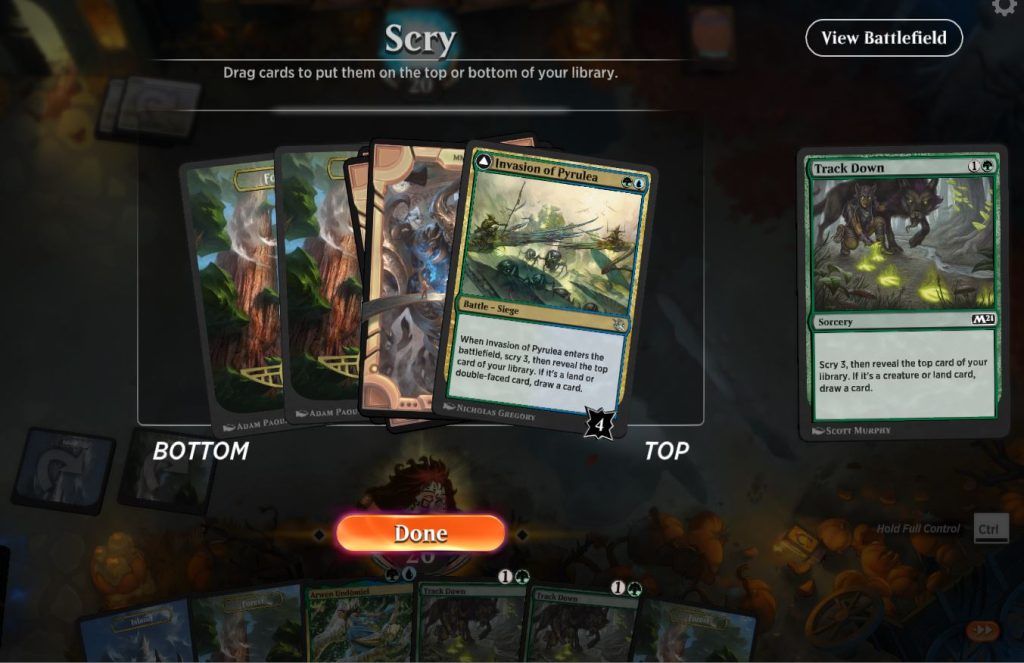
After Track Down resolves, you’ll see the card you left on top of your library face-up. That won’t be visible to your opponent; it’s just there as a friendly reminder since it’s technically known information. If you click your library, you’ll see the exact position of every card you know about in your library. The battle is on top, and if you were to scroll all the way to the left, you’d see two Forests on the bottom.
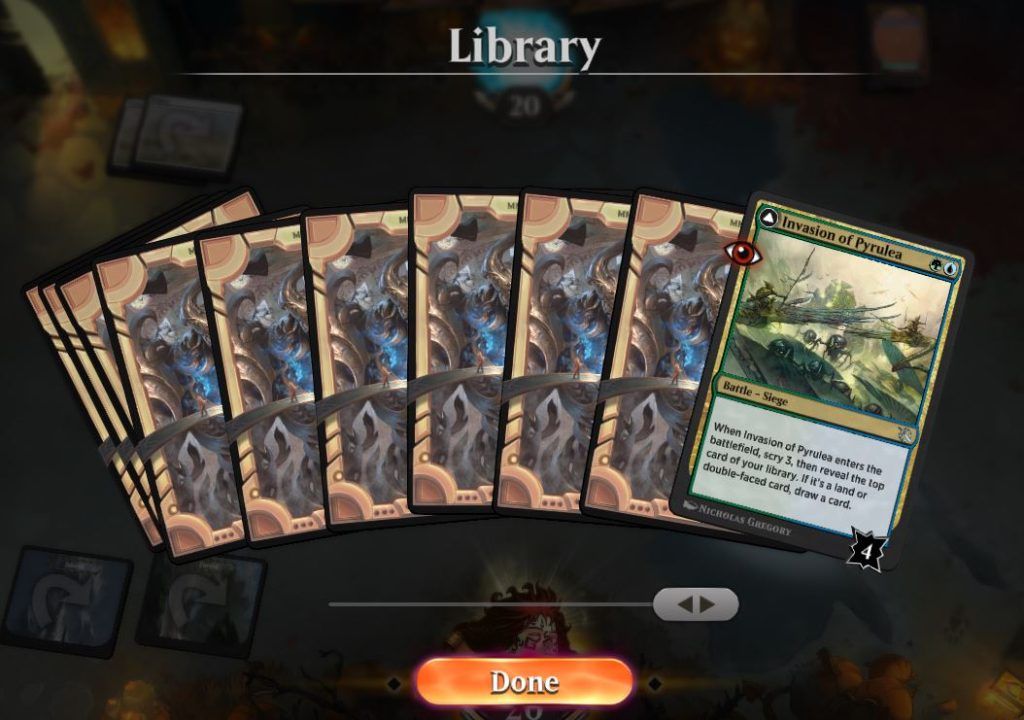
All that’s left is to show Sparky some manners.
What Is the “Scrycast” Mechanic?
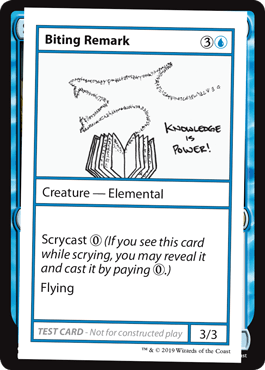
“Scrycast” appeared on a single playtest card from the original wave of Mystery Boosters. These were cards that introduced strange gimmicks into the game, sometimes as a joke, but also as a way to showcase some of the ideas Magic R&D was toying around with.
The card in question is Biting Remark, which has “Scrycast .” That means if you reveal the card while scrying, you can cast it by paying the Scrycast cost (in this case casting it for free). I’m sure there are some real rules quirks with this, but I wouldn’t be surprised to see something like this down the line. After all, “flying counters” debuted on a playtest card before they were made official in Ikoria.
Scry vs. Scrye
As far as I can tell, “scrye” with an E isn’t a real word, unless you’re talking about some gaming publication from the early 2000’s. It’s certainly not the accepted use of the term in Magic, which has always been written as “scry,” sans E.
Decklist: Eligeth & Thrasios, Partners in Scryme in Casual Commander
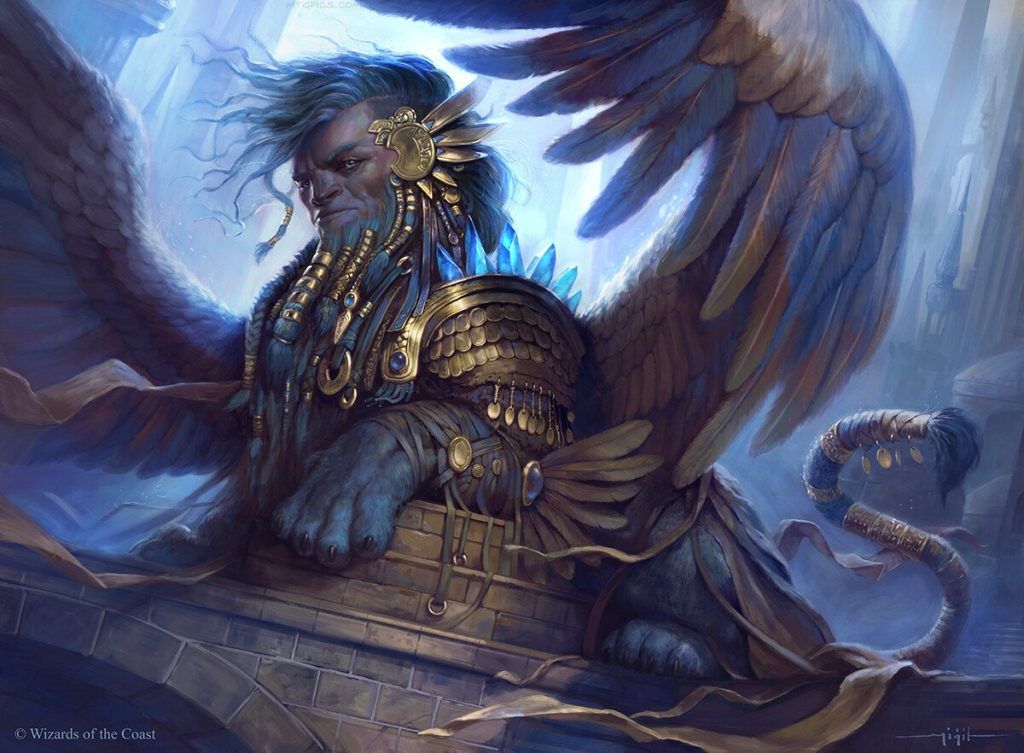
Eligeth, Crossroads Augur | Illustration by Yigit Koroglu
Commanders (2)
Eligeth, Crossroads Augur
Thrasios, Triton Hero
Creature (24)
Arwen Undómiel
Sakura-Tribe Elder
The Reality Chip
Dryad Greenseeker
Jolrael, Mwonvuli Recluse
Coiling Oracle
Kenessos, Priest of Thassa
Triskaidekaphile
Azusa, Lost but Seeking
Storm Fleet Negotiator
Courser of Kruphix
Elvish Mariner
Vesuvan Drifter
Glorfindel, Dauntless Rescuer
Conundrum Sphinx
Jolrael, Voice of Zhalfir
Ethereal Investigator
Alandra, Sky Dreamer
Rashmi, Eternities Crafter
Deepfathom Echo
Biting Remark
Galadriel of Lothlórien
Elrond, Master of Healing
Deceiver of Form
Instant (9)
Opt
Condescend
Council's Deliberation
Reality Shift
Joint Exploration
Counterspell
Beast Within
Vanishment
Commence the Endgame
Sorcery (9)
Mystic Speculation
Elven Farsight
Reason / Believe
Preordain
Ponder
Serum Visions
Devastation Tide
Lórien Revealed
Temporal Mastery
Enchantment (6)
Burgeoning
Sylvan Library
Lost Isle Calling
Counterbalance
Swindler's Scheme
Lurking Predators
Planeswalker (2)
Nissa, Steward of Elements
Teferi, Temporal Pilgrim
Artifact (10)
Sol Ring
Arcane Signet
Talisman of Curiosity
Simic Signet
Sapphire Medallion
Thought Vessel
Lifecrafter's Bestiary
Druidic Satchel
Psychosis Crawler
The Temporal Anchor
Land 38 (38)
Temple of Mystery
Temple of the False God
Crystal Grotto
Zhalfirin Void
Myriad Landscape
Reliquary Tower
The Biblioplex
Rivendell
Castle Vantress
Soldevi Excavations
Command Tower
Flooded Grove
Rejuvenating Spring
Simic Growth Chamber
Quandrix Campus
Waterlogged Grove
Breeding Pool
Hinterland Harbor
Dreamroot Cascade
Restless Vinestalk
Barkchannel Pathway / Tidechannel Pathway
Forest x8
Island x9
Scry’s got its fair share of support cards, but not quite enough to make up an entire Commander deck. That means you have to get a little tricky, combining scry with effects that manipulate the top of your library. Here I’ve put together the “partners in scryme” Eligeth, Crossroads Augur and Thrasios, Triton Hero for a fun, laid back casual deck using scry as the driving force behind most of its cards.
The deck uses the scry mechanic to set up miracles like Temporal Mastery, value engines like Druidic Satchel, and your only real hard control piece, Counterbalance. Once Eligeth hits the board, all your scrys turn into straight-up card draw, and from there you can stock cards in hand and go big with your wincons.
The fun part is all the different, unique wincons you can experiment with. No Triumph of the Hordes or Craterhoof Behemoths here. No, this deck tries to win by loading your hand up for Triskaidekaphile, overrunning your opponents with Jolrael, Mwonvuli Recluse, or going for death by 1,000 cuts with Psychosis Crawler.
Note that I was inspired to include Biting Remark, which obviously isn’t legal for sanctioned play. Talk to your casual groups before running this card, though it isn’t exceptionally broken or anything for people to worry about.
Scry Me A River

Temple of Abandon | Illustration by Adam Paquette
That’s where my vision of your future ends, dear reader! We saw much to look forward to, though admittedly it looked like a lot of wheel-spinning and topdeck reordering to me.
Scry’s great, point blank. Mechanics that help smooth out games are always welcome, and upgrading it to an evergreen mechanic was a great decision. I used to be one of those complainers who said “wow, they tack on scry to everything now!” But now Treasure tokens exist so I do most of my complaining about those instead.
What are your opinions on scry? Do you like how frequently it shows up, and do you have any scrying coming up in your future? Let me know in the comments below or over in the Draftsim Discord.
Thank you for making Draftsim your #1 stop for all things Magic!
Follow Draftsim for awesome articles and set updates: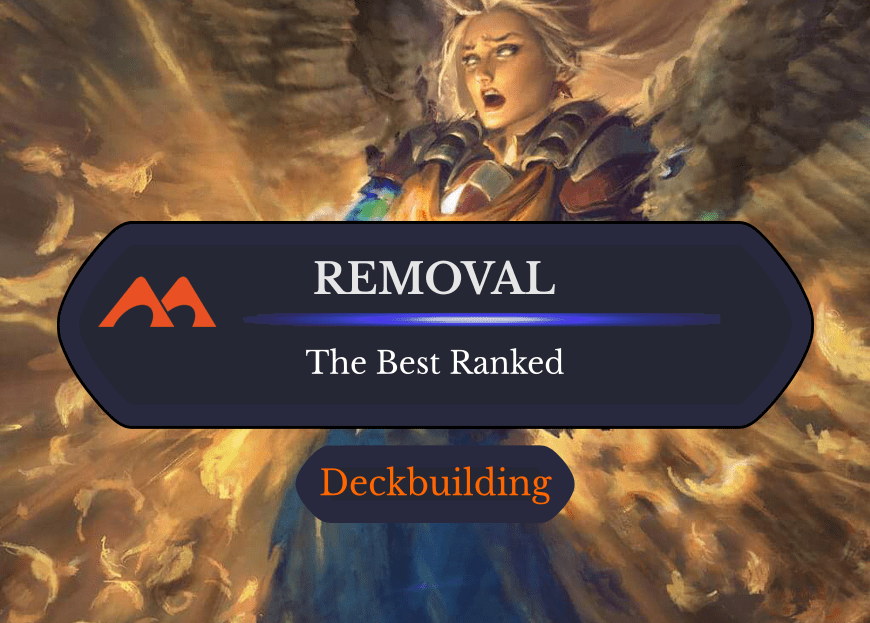

2 Comments
When you scry and decide to keep the card and place it on top, is it placed face up on the library?
Nope! MTGA may do that for your convenience, but that is not public information known to your opponent.
Add Comment